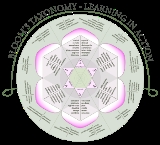
Taxonomy of Educational Objectives
Overview
Bloom's Taxonomy is a classification of learning objectives within education proposed in 1956 by a committee of educators chaired by Benjamin Bloom
who also edited the first volume of the standard text, Taxonomy of educational objectives: the classification of educational goals (referred to as simply "the Handbook" below). Although named for Bloom, the publication followed a series of conferences from 1949 to 1953, which were designed to improve communication between educators on the design of curricula and examinations.
It refers to a classification of the different objectives that educators
set for students (learning objectives).
Bloom's Taxonomy divides educational objectives into three "domains": Cognitive, Affective, and Psychomotor
(sometimes loosely described as knowing/head, feeling/heart and doing/hands respectively).
Benjamin Bloom
Benjamin Samuel Bloom was an American educational psychologist who made contributions to the classification of educational objectives and to the theory of mastery-learning...
who also edited the first volume of the standard text, Taxonomy of educational objectives: the classification of educational goals (referred to as simply "the Handbook" below). Although named for Bloom, the publication followed a series of conferences from 1949 to 1953, which were designed to improve communication between educators on the design of curricula and examinations.
It refers to a classification of the different objectives that educators
Education
Education in its broadest, general sense is the means through which the aims and habits of a group of people lives on from one generation to the next. Generally, it occurs through any experience that has a formative effect on the way one thinks, feels, or acts...
set for students (learning objectives).
Bloom's Taxonomy divides educational objectives into three "domains": Cognitive, Affective, and Psychomotor
Psychomotor learning
Psychomotor learning is the relationship between cognitive functions and physical movement. Psychomotor learning is demonstrated by physical skills such as movement, coordination, manipulation, dexterity, grace, strength, speed; actions which...
(sometimes loosely described as knowing/head, feeling/heart and doing/hands respectively).
Unanswered Questions
Discussions

